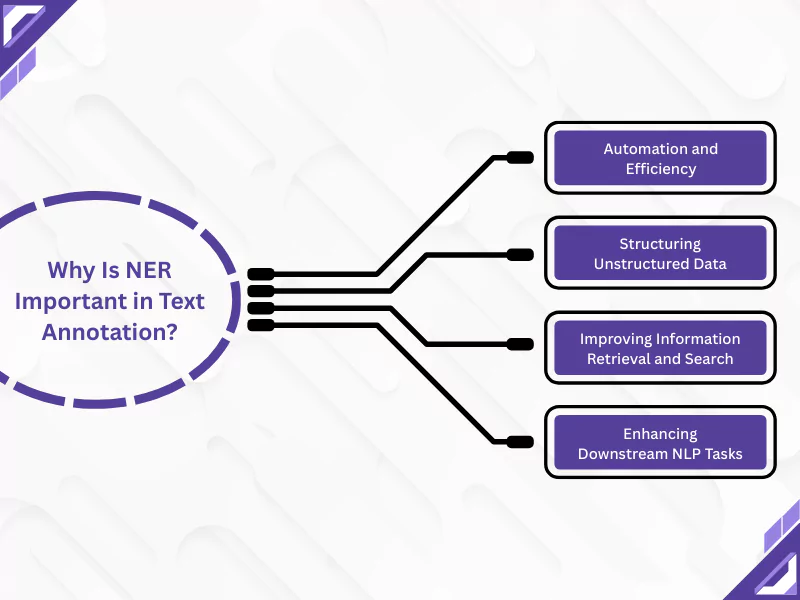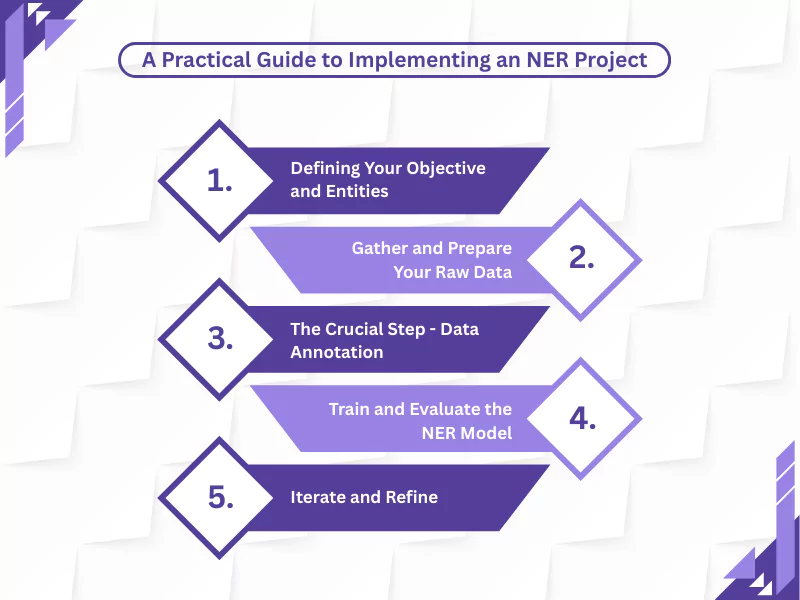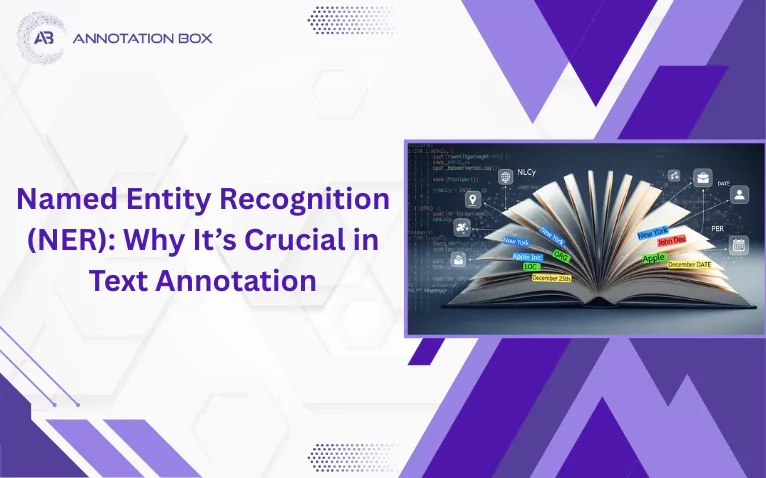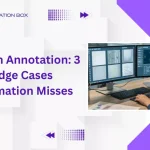In the age of ‘information overload,’ it is crucial to enable machines to understand the content of the information. Businesses generate massive amounts of text data, including customer reviews, emails, social media comments, legal documents, and medical records. Since all of these are unstructured data, computers fail to understand the context or meaning of the words.
Named entity recognition is a method to identify and classify key information, entities like names of people, organizations, locations, dates, and other entities within a text. The Natural Language Processing technique plays a crucial role in helping computers understand the key information.
This blog will guide you through the meaning of NER and explain why it is crucial in text annotation.
The process of Named Entity Recognition involves identifying and classifying key pieces of information, or named entities, in a piece of text. Here’s a detailed explanation of the process:
A. Identification
First, NER identifies the spans of text representing named entities. For example, in the sentence, ‘John from the sales department said that the Tar Heel hotel in the US is a great hotel for staying in the US,’ NER would identify ‘John,’ ‘Tar Heel’, and the ‘US’ as potential entities.
B. Entity Classification
Once the technique identifies the entities, NER classifies them into specific categories. For example, ‘John’ will be classified as ‘PERSON’, ‘Tar Heel’ as ‘ORGANIZATION’, and the ‘US’ as a GEOPOLITICAL ENTITY.’
C. Purpose
NER is the most important component for numerous Natural Language Processing applications, including rules for information extraction, question answering, and machine translation. The process helps machines understand the context and meaning of text by identifying and categorizing named entities.
Examples of NER applications include customer support, cybersecurity, and research.
That will help you understand what NER is, but why is NER important in text annotation? Let’s elaborate. (Case Study)
Why Is NER Important in Text Annotation?

NER transforms unstructured text into structured, readily usable data. The following points will explain the importance of NER in text annotation in detail:
A. Automation and Efficiency
Annotating a large volume of text manually is time-consuming and expensive. NER automates the data labeling process, a crucial step for training machine learning models. The technique identifies and tags entities, such as existing entity names, locations, and dates, automatically, thereby reducing the need for human effort and speeding up and scaling text processing.
B. Structuring Unstructured Data
The danger of information overload is something all of us need to deal with. Since most of the data exists in an unstructured format, applying the NER technique becomes even more crucial. NER helps convert unstructured data into a structured format, making it easier for machines to understand and analyze.
C. Improving Information Retrieval and Search
NER enhances the ability of search engines and information retrieval systems to understand the context of a query by tagging entities within a text. Consequently, this leads to more precise and relevant search results.
D. Enhancing Downstream NLP Tasks
NER plays a crucial role in improving downstream NLP tasks. The structured data created by NER acts as the starting point for tasks like:
- Question answering – Machines can identify potential answers to questions by identifying the specific named entity types.
- Sentiment analysis – NER helps determine the sentiment towards a specific person, product, or organization mentioned in a sentence.
- Text summarization – NER helps create coherent and entity-focused summaries by identifying the most important entities.
That explains why NER is important in text annotation. But what are the NER tasks and methods used for successful text annotation? The following section will take you through the different NER methods.
Exploring the Different NER Methods Used for Text Annotation
A. Lexicon-Based Method
The Lexicon-based method for Named Entity Recognition relies on a pre-built dictionary or lexicon of known entities to identify and classify named entities within text. In this method, the entity identification depends on the presence of the dictionary words within a given text. The method is simple, but it needs constant updates and careful maintenance of the dictionary. These make it less commonly used due to its high maintenance demands.
B. Rule-Based Methods
Rule-based NER methods rely on manually crafted rules and patterns for identifying and categorizing entities. The rules can be pattern-based (focused on the structure and form of words, including morphological patterns) or context-based (focused on surrounding words or the context in which a word appears). Combining these types of rules enhances accuracy.
C. Machine Learning-Based NER Methods
The method involves training AI-driven large language models on labelled datasets. The method includes:
➤ Multi-class classification – The AI models are trained to categorize each entity, which requires a deeper understanding of the context. This can be challenging for simple algorithms.
➤ Conditional Random Field (CRF) – This is a probabilistic model that understands the context and sequence of words, leading to accurate entity predictions. CRFs are often used with LSTMs for modeling the conditional probability of an entire label sequence. Using algorithms like CRF helps with the NER process.
D. Deep Learning Methods
The method uses neural networks, thus offering significant advancements in deep learning techniques, such as:
➤ Word embeddings – Capturing the meaning of a word or phrase based on its context.
➤ Automatic learning – The method enables pre-trained NER models to understand complex patterns without requiring manual feature engineering.
➤ Higher accuracy – It helps achieve better performance on large and diverse datasets.
➤ Recurrent neural networks and long short-term memory (LSTM) – RNNs are designed for sequence prediction. LSTMs are a special type of RNN that can recognize patterns over time and retain information across long sequences, thereby improving context understanding.
➤ Transformers and BERT (Bidirectional Encoder Representations from Transformers) – Transformer networks, specifically BERT, utilize a self-attention mechanism to comprehend the significance of different words. It considers the full context of a word in deep learning approaches.
E. Hybrid Approaches
The hybrid approach combines rule-based and traditional machine learning methods, thus using the strengths of both. It allows the use of rules for easy entities and machine learning approaches for more complex ones. This makes them valuable for different data sources.
These methods are widely used to ensure machines understand the context within a text and deliver accurate results. You can also look for a Python library for advanced NLP. On that note, it is also necessary to understand how NER is implemented.
A Comprehensive Guide to Implementing NER Project

You need to understand how to implement an NER project in addition to the methods. While there are multiple methods, the process from collecting raw, unstructured data to a functional NER model generally follows these five steps:
1. Defining Your Objective and Recognizing Entities
Before using any of the methods, you need to understand why you need them. So, even before you start, you must first identify the business problem you are having and how NER can solve it. Once you identify the problem, it will be easier for you to predefine the entities and understand why you need to implement an NER project.
2. Gather and Prepare Your Raw Data
The second step for using NER properly is to collect and prepare your raw data. It involves gathering a representative sample of the text you want the model to analyze. The dataset includes:
➤ Customer emails
➤ Social media comments
➤ Physician’s notes
➤ Legal agreements
The point here is to collect data that highlights the complexity and variety the NER model would face once it’s put into action.
3. The Crucial Step – Data Annotation
Data annotation is the central part of the entire process. Here you encode human expertise into your data. While this is one of the steps in implementation, it is a mini-project in itself. Here’s how you can achieve it:
➤ Create clean and clear annotation guidelines
➤ Choose the right company for data annotation services
➤ Get labeled data delivered
This is the most critical part of the implementation process, explaining how NER improves data annotation accuracy.
4. Train and Evaluate the NER Model
The high-quality annotated dataset will help you train your machine learning in NER. Here’s how you must go about it:
➤ Split the data
◆ Training data set (80%)
◆ Validation set (10%)
◆ Test set (10%)
➤ Train the model – Choose a model and train it on the labeled training set
➤ Evaluate performance – Use the test set to understand how your model is performing. It will help you learn about the accuracy and reliability of the model.
5. Iterate and Refine
You cannot expect the model to be perfect on the first try. Evaluating the model will help understand the types of mistakes the model is making. The next few steps will help you decide on the final result:
➤ Error analysis
➤ Refine guidelines and data
➤ Re-annotate and retrain
The annotating, training, and evaluating process will be repeated till the model’s performance meets the required level for your business goal. Once that reaches a satisfactory level, it is ready for deployment.
You need to understand how implementing modern NER systems properly is crucial for better results. The next section will take you through some use cases to give you a better understanding of how NER plays a crucial role in text annotation.
NER Applications: Use Cases for Better Understanding
It is crucial to understand the real-life applications of NER for a better understanding of the importance of NER in text annotation. The following are a few use cases:
A. Information Extraction
NER is crucial for extracting information from large, unstructured databases, thereby improving search engine relevance and precision.
B. Automated News Aggregation
The system helps identify and categorize articles based on named entities, enabling the presentation of news in an effective and organized manner.
C. Social Media Monitoring
NER helps identify key entities in posts and comments, which enables understanding of trends and public opinions to inform the formulation of marketing or customer service strategies. The process facilitates effective content moderation.
D. Chatbots and Virtual Assistants
The system enables AI tools to accurately understand user requests by identifying critical entities in queries, thereby providing precise, context-specific responses.
E. Cybersecurity
NER systems help identify potential threats and exceptions in network logs. This helps improve security and also in investigations.
F. Resume Analysis
The model helps filter candidates by extracting skills and attributes from resumes and matching them with job requirements.
Well-implemented NER systems can help streamline numerous processes and play a crucial role in text annotation.
Final Thoughts,
NER in text annotation is crucial for machine learning models. The system helps businesses understand various entities and makes it easier for them to make informed decisions. It has a wide variety of applications.
You can look for text annotation services to get things done fast. Understand the importance of NER and implement the system for better results.
Frequently Asked Questions
Why is NER important in NLP?
NER is one of the crucial parts of NLP. It helps in identifying named entities. The entity recognition system processes unstructured text by extracting and structuring crucial entities. The process helps machines look into vast amounts of data and extract information from unstructured data.
What are the advantages of NER?
NER systems can help streamline knowledge management efforts by extracting and organizing entities from internal documents, legal reports, or customer feedback. The process follows a set of rules to ensure it can identify entities like entity names, organizations, etc.
What is the primary goal of NER?
These terms are generally used interchangeably. While both refer to adding tags to data for AI models, annotation implies more complex tasks, compared to data labeling.
Where can NER be used?
NER systems have various applications, like entity recognition, question answering, information retrieval, and machine learning or deep learning applications.






